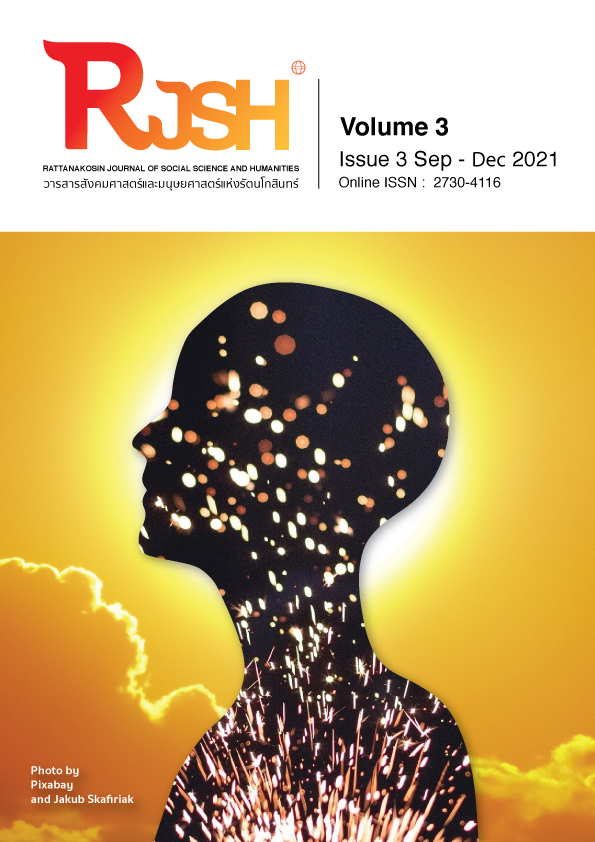Healthy Low Energy Kularb – Arlua Dessert from Aromatic Coconut
Main Article Content
Abstract
Arlua is a dessert with a sweet taste, beautiful appearance and color, but high in calories due to the coconut milk as the main ingredient. Therefore, this research focused on studying the use of aromatic coconut, the main economic crop of Nakhon Pathom province, to partially substitute coconut milk to reduce the energy value of the dessert by using 3 standard formulas of Arlua. For sensory acceptance tests by 30 panelists, it was found that the standard formula containing all-purpose flour, sugar and coconut milk at 10.35, 34.48 and 55.17%, respectively, and baked at 70 °C for 14 hours was the most accepted due to its beautiful color and good texture. Then, the formula was adjusted to reduce the amount of coconut milk by using 25, 50 and 75% of aromatic coconut. For the sensory acceptance testing by 30 panelists, it was found that the 75% of aromatic coconut substitution with coconut milk was more acceptable than other formulas and provides 40% less energy per piece (22.76 kcal) compared with the standard formula at 37.70 kcal per piece. Therefore, Kularb- Arlua Dessert, which uses 75 % of aromatic coconut instead of coconut milk, can be developed into a healthy dessert.
Article Details
The content within the published articles, including images and tables, is copyrighted by Rajamangala University of Technology Rattanakosin. Any use of the article's content, text, ideas, images, or tables for commercial purposes in various formats requires permission from the journal's editorial board.
Rajamangala University of Technology Rattanakosin permits the use and dissemination of article files under the condition that proper attribution to the journal is provided and the content is not used for commercial purposes.
The opinions and views expressed in the articles are solely those of the respective authors and are not associated with Rajamangala University of Technology Rattanakosin or other faculty members in the university. The authors bear full responsibility for the content of their articles, including any errors, and are responsible for the content and editorial review. The editorial board is not responsible for the content or views expressed in the articles.
References
กลุ่มยุทธศาสตร์และแผนงาน สำนักโรคไม่ติดต่อ. (2559). รายงานประจำปี 2558. กรุงเทพฯ:สำนักงานกิจการโรงพิมพ์องค์การสงเคราะห์.
กองโภชนาการ กระทรวงสาธารณสุข. (2544). ตารางแสดงคุณค่าทางโภชนาการของอาหารไทย Nutritive Values of Thai Food. กรุงเทพฯ.
กิจติยา แคดี. (2557). ขนมไทย. กรุงเทพฯ: สำนักพิมพ์แม่บ้าน.
คณาจารย์ ภาควิชาวิทยาศาสตร์และเทคโนโลยีอาหาร มหาวิทยาลัยเกษตรศาสตร์. (2539). วิทยาศาสตร์และเทคโนโลยีการอาหาร. กรุงเทพฯ: สำนักพิมพ์มหาวิทยาลัยเกษตรศาสตร์.
จริยา เดชกุญชร. (2549). ขนมไทยเล่ม 1. กรุงเทพฯ: บริษัทวี.พริ้นท์.
ธัญนันท์ อบถม. (2555). ขนมหวานไทย. กรุงเทพฯ: สำนักพิมพ์อมรินทร์.
รุ่งทิวา วงศ์ไพศาลฤทธิ์. (2553). ขนมไทยชาววัง. กรุงเทพฯ: บริษัทพิมพ์ดีการพิมพ์ จำกัด.
วันดี ณ สงขลา. (2544). ขนมไทยไม่ง่ายอย่างที่คิด ตอน อาลัว. นิตยสารแม่บ้าน, 25(383), 57-58.
สิริพันธุ์ จุลกรังคะ. (2558). โภชนาการศาสตร์เบื้องต้น. กรุงเทพฯ: สำนักพิมพ์มหาวิทยาลัยเกษตรศาสตร์.
อบเชย วงศ์ทอง. (2554). หลักการประกอบอาหาร. พิมพ์ครั้งที่ 6. กรุงเทพฯ: สำนักพิมพ์มหาวิทยาลัยเกษตรศาสตร์.
อาฒยา สันตะกุล, อบเชย วงศ์ทอง และกาญจน ลุศนันทน์. (2549). การพัฒนาขนมอาลัวให้ได้สูตรมาตรฐาน. วิทยานิพนธ์มหาบัณฑิต, มหาวิทยาลัยเกษตรศาสตร์.


